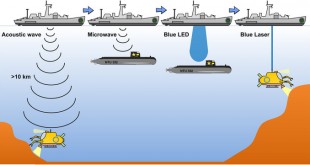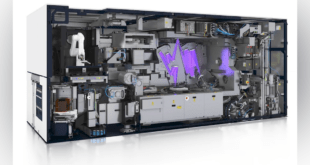Electromagnetic energy, produced by the vibration of charged particles, travels in the form of waves through the atmosphere and the vacuum of space. These waves have different wavelengths (the distance from wave crest to wave crest) and frequencies, These two are inversely related to each other, the shorter the wavelength, the higher the frequency.
The infrared (IR) region which covers the wavelength range from approximately 0.7 µm to 100 µm – more than 100 times as wide as the visible portion. Infrared waves have longer wavelengths than visible light and can pass through dense regions of gas and dust in space with less scattering and absorption. Thus, infrared energy can also reveal objects in the universe that cannot be seen in visible light using optical telescopes.
Infrared photodetectors (IRPDs) have become important devices in various applications such as night vision, military missile tracking, medical imaging, industry defect imaging, environmental sensing, and exoplanet exploration. For an IRPD to work, a light-sensitive material capable of absorbing electromagnetic radiation is needed. It converts the absorbed light into a signal that can be collected by a readout device.
Current IR detection techniques rely either on photodetection or thermal detection. While IR photodetectors can, in principle, achieve quantum levels of sensitivity, they require cryogenic cooling to mitigate dark current and other noise sources.
In contrast, thermal detectors such as microbolometers can operate at room temperature but offer far lower performance levels. As a result, there is a significant performance gap in IR detection technology between uncooled thermal detectors and cryogenically cooled photodetectors. Further, these detection strategies are often limited by low material responsivity, high levels of electronic noise, fabrication complexities, and other limitations of readout
integrated circuits (ROICs).
Alternate paradigms for uncooled IR detection have emerged in recent years based on microelectromechanical resonators and optomechanical resonators. In contrast to bolometers that rely on transducing absorbed IR radiation into changes of electrical resistance, microresonator based IR detectors transduce absorbed radiation into corresponding frequency shifts of their resonant modes.
Detecting IR radiation in this manner offers numerous advantages over conventional uncooled bolometers. First, extensive efforts by the microelectromechanical systems (MEMS) and optomechanics community have resulted in the development of ultra coherent thin film resonators that exhibit room temperature quality factors in excess of 106 -107 in a variety of materials, including crystalline silicon, silicon nitride, silicon carbide, and diamond thin films. The low thermomechanical noise and high isolation from environmental perturbations also lead to extremely small (sub-ppb) levels of short-term fractional frequency instability.
The key to potentially realizing this giant technological leap in IR sensing comes from the synergy of combining the best aspects of three sensor paradigms: First, optomechanical resonators – tiny trampoline-like structures – offer a high isolation, ultrasensitive platform; second, all-optical detectors yield low-noise, quantum-level detection; and third, designer metamaterials with spectrally selective “made-to-order” IR absorption allow for extremely precise detection of desired wavelengths.
“Trying to enhance IR sensing capabilities using any one of those methods by itself would be hard, but not too hard,” Vengalattore said. “What makes OpTIm such an incredibly difficult challenge, with revolutionary impact if we’re successful, is combining all three. We are not looking to merely augment existing IR detection modalities with evolutionary improvements in signal readout, noise mitigation, or spectral selectivity. What makes this program exciting from a scientific perspective and an application-oriented perspective is that OpTIm seeks to bring together innovative solutions at the confluence of optomechanics, materials physics, photonics, and metrology to take a fresh look at an old problem. At the end of the day, for all the applications that spring to mind with the projected capabilities of OpTIm-based detectors, there are probably many more applications that we haven’t yet imagined that will be engendered by this new regime of IR detection.”
Program Description/Scope
DARPA launched OpTIm program in Sep 2022, seeking to build upon these nascent efforts to demonstrate a new class of room-temperature, integrated optomechanical IR detectors in the MWIR and LWIR regimes with performance metrics that bridge the gap between room temperature microbolometers and cryogenic, quantum-limited IR photodetectors. To this end, OpTIm will explore a diverse space of intrinsic IR-sensitive materials, nano-assembled metamaterials, and heterostructures that combine enhanced IR-absorption, multispectral, or polarization-sensitive IR capabilities with high-Q optomechanical resonator integration and quantum-limited optical readout.
Based on this exploration, OpTIm will validate and benchmark the essential elements of this novel IR detection concept; these elements are
(i) Spectrally tailored narrowband, multispectral or polarization-sensitive IR absorption in high-Q thin-film resonators or heterostructure membrane resonators;
(ii) IR-induced frequency shifts in the resonator eigenmodes that can be rapidly and accurately determined owing to the high intrinsic quality factors, low thermomechanical noise, low thermal mass, and low fractional frequency instability of these resonators; and
(iii) All-optical detection of these frequency shifts close to, or at, quantum-limited precision by harnessing visible or near-IR photodetection technology. Such all-optical protocols can potentially circumvent issues of ROIC-induced noise sources, fabrication incompatibilities or related issues that have hampered conventional microbolometer technology.
OpTIm also aims to establish fundamental sensitivity, bandwidth, noise, and performance limits of this new modality of IR detection.
OpTIm is a 60-month program broken into two 30-month phases where teams will aim to validate, characterize, and benchmark this new class of optomechanical IR detectors. A Proposers Day webcast was held on September 9, 2022.
“If researchers can meet the program’s metrics, we will enable IR detection with orders-of-magnitude improvements in sensitivity, spectral control, and response time over current room-temperature IR devices,” said Mukund Vengalattore, OpTIm program manager in DARPA’s Defense Sciences Office. “Achieving quantum-level sensitivity in room-temperature, compact IR sensors would transform battlefield surveillance, night vision, and terrestrial and space imaging. It would also enable a host of commercial applications including infrared spectroscopy for non-invasive cancer diagnosis, highly accurate and immediate pathogen detection from a person’s breath or in the air, and pre-disease detection of threats to agriculture and foliage health.”
 International Defense Security & Technology Your trusted Source for News, Research and Analysis
International Defense Security & Technology Your trusted Source for News, Research and Analysis

